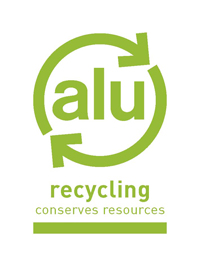The alu tube - a symbol for sustainability
Today, each product stands ever more in the public focus, judged by aspects of its sustainability. The packaging industry offers a multitude of different packaging materials. Nevertheless, of all modern materials there is one that shows obvious advantages in terms of ecological performance – the aluminium tube.
On the social and political scale, the ecological aspects of economic action have become more and more important, especially concerning the tasks of a sustainable use of natural resources and the energy balance of manufactured goods. The modern packaging industry has recognised this topic as highly relevant. Consequently, it offers excellent packaging, like the aluminium tube, to customers for their high-quality products. In fact, these tubes match perfectly with today’s requirements for sustainability, due to their outstanding recycling and barrier properties, which differentiate the aluminium tube most clearly from other packaging materials.
Care for future generations
Which resources or raw materials would have competitive advantages if the interests of coming generations are taken into account? With non-renewable resources it would definitely be those which are abundantly available in nature and which can be easily recycled without material losses. These aspects match with the aluminium tube in an exemplary way. 8 percent of the earth’s crust consist of aluminium, the raw material for the production of aluminium tubes. That makes this natural resource the third most often occurring element on our planet. And recycling of used aluminium – from whatever source – is a matter of fact today.
Recycling saves natural resources
Aluminium can claim to be a permanent material, one for which the inherent properties do not change during use and following repeated recycling into new products. Aluminium tubes and other packages of this light metal are fed into a closed recycling circle. In Europe, recycling rates up to 90 percent are reached thanks to the employment of modern eddy-current sorting technology and special collection systems. Due to their high purity grade, aluminium tubes are in great demand as recycling material. Given today's sophisticated aluminium recycling system, recycled aluminium tubes find a second life in such high-tech applications as ultramodern Airbus aircraft or fancy sports cars. So there is no downcycling with aluminium. Other packaging materials do not have such a good recycling performance, what makes the aluminium tube one of the most effective recycling materials. Especially under energy saving aspects, the recycling of aluminium packaging from household waste is ecologically reasonable. Recycling of used aluminium saves up to 95 percent compared to the energy costs of the production of primary aluminium. Hence, the aluminium tube is a little “energy bank”.
Excellent barrier properties preserve the content and conserve resources
Thanks to aluminium’s excellent barrier properties the product is efficiently protected so that food waste and loss are prevented. This is fully in line with the aims of the internationally well-known “Save Food” initiative which is supported by the Food and Agriculture Organization of the United Nations (FAO) and the United Nations Environment Programme (UNEP).
The purpose of tubes is to maintain the freshness and quality of up-market, paste-type products such as beauty or pharmaceutical creams – and to protect them from detrimental effects. That reduces the need for added preservatives, protects the active substances and prevents the content from spoiling or desiccating. In addition no valuable ingredients can get out of the tube. Yet, reducing the positive effects of aluminium packaging to these two aspects would make it too short, especially when thinking about a holistic energy balance. Considerable advantages of the aluminium tube also lie in the inclusion of the overall energy use into the calculation for the tube’s energy balance, i.e. from the production of the filling up to the recycling of the tube. For example, the production of a high-quality ointment uses much energy, which would be lost in case of spoiling. Another positive aspect in this respect is the complete emptying property of the aluminium tube. Thus, no contents are wasted and also not the energy used for the production of these contents.
